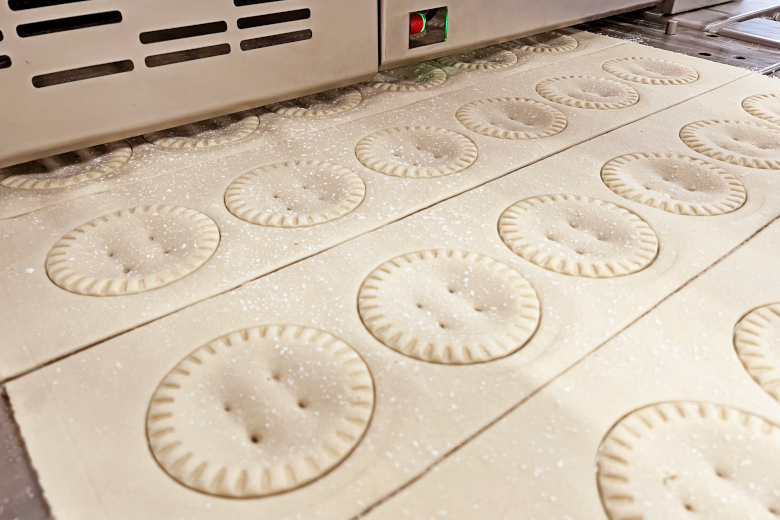
Sweet or savory, pies are a perennial favorite among consumers. Highly specialized production lines are developed to ensure production meets quantity as well as quality needs, efficiently. They are also designed to be operated with ease and safety.
Pie and quiche line – Rademaker
The Rademaker Pie and Quiche line is developed to produce an extensive assortment of pies and quiches from all cultures, ranging from meat pies, fruit pies, egg tarts (such as the beloved Pasta del Nata) and cheesecakes, to Melton pies, pork pies and even quiches; pies with an open top or closed with a dough lid, or crumbled top. Products can be made in different foils, paper containers, metal baking trays, hoops, tins as well as indented baking trays.
The line can be built with working widths ranging between 600 mm to 1,200 mm wide. Depending on the width and the product size, production capacities can go as high as 20,000 pieces per hour – for pies 80 mm in diameter. For 250 mm-diameter pies, the hourly production capacity can reach 5,200 pieces, while for egg tarts or Pastel de Nata, it sits between 9,000 to 36,000 per hour. It can also produce 3,000 – 7,200 quiches per hour, to illustrate some of the main product categories.
This versatile line can be used interchangeably for a wide product variety without the need to make any changes to its configuration. When changing product sizes, the only changeover required is that of the product-specific parts (e.g., the size and shape of the foils and platens, the size of the blocking and crimping head). And changing from sweet to savory pies is simply a manner of switching to the desired filling in the depositor. Of course, fillings are widely varied in consistency – here, Rademaker recommends the best-fitting depositor for the specific product/range: “Either a spot depositor, mono pump or gearwheel depositor can be used, in combination with nozzles that can have both ‘shut off’ and ‘blow off’ functionality. In some instances, ‘shower head’ nozzles are used to deposit through multiple outlets over the surface of the pie,” Rademaker’s specialists illustrate.

Before the pie line is delivered, filling accuracy is optimized for the characteristics of the desired fillings in the operator panel, and the settings are saved.
Depositing accuracy is ensured with direct-drive servo motors, which allow repeatable, recipe-controlled position settings from the beginning of the run. Multiple depositing parameters are defined and can be controlled, including target weight, speed, or starting and closing time of the nozzle (and many more that will further fine-tune the process). “Some features such as ‘no product- no deposit’ can be designed into the line. For example, if a foil is missing on the conveyor, then the depositor does not deposit into the empty spot,” Rademaker shares.
For product decoration, there are several available options with this pie and quiche line, including dough lids with different designs, in addition to lattices and crumbs.
Drawing from the wish list
To design a line that produces complex products to specifications, Rademaker collects all possible ‘wish list’ items first. “By thinking through these ‘what ifs’ in advance, the goal is to achieve a line design that can allow different depositors or applicators to be placed at different locations or stages through the process. It is also important to understand the ingredient delivery to the production line that these products may require,” the specialists explain.
Rademaker’s R&D has recently focused on improving the line’s safety, maintenance and hygiene features. The pie and quiche line allows fast removal of essential parts for easy access during cleaning and maintenance operations.
“Of course, all parts are designed within the ergonomic Rademaker Sigma® guidelines with a special focus on rounded edges and process visibility,” Rademaker’s team explains. For improved safety, access to various key parts is controlled by sensors. The same guidelines are also reflected in the line’s hygienic features, as they take into consideration various standards and certification requirements, such as the machine’s finishings, angled surfaces, food-contact-approved plastic parts in the standard blue color, and having hinges and bolts reduced to an absolute minimum. It is also entirely designed with washdown in mind.
Servo controls have also been optimized, to accurately control positioning as well as motion. Rademaker details: “For example, the servo control of a production line ensures the proper positioning for each of the units’ operations, which is critical if the line is required to run multiple sizes.” Digital line control, whether PLC or PC-based, is given, and utilized for recipe management and line performance monitoring.
With this and any fully automated production line, process optimization is a direct result of several factors, from the setup and ensuring it is maintained in good condition. The consistency of the incoming ingredients and operators’ skills also contribute to operational efficiency. Continuous specialization in running and maintaining technology is as important as having the latest-generation technology. It spells success for the people, the production line, and the quality of the products – for any of today’s and tomorrow’s favorite pies, too.
Rademaker pie and quiche line specifications
- Working widths between 600 mm to 1,200 mm wide
- Production capacities of up to 20,000 pieces per hour (for pies 80 mm in diameter)
- Quiche production ranges from 3,000 to 7,000 per hour
- Egg tarts/Pastel de nata capacity between 9,000 to 36,000 per hour
The article is part of an extended feature on pies, published in Baking+Biscuit International, issue 2 – 2023.
Photo: Pexels (#13279214)


